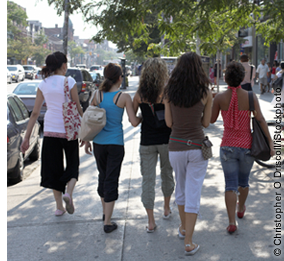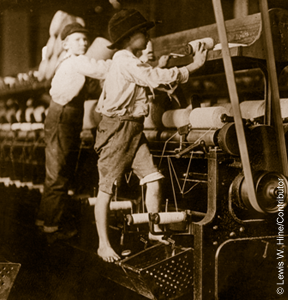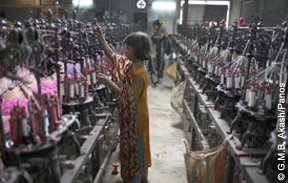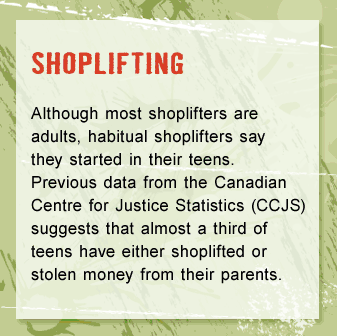MSNBC
Shopping centre in Cleveland follows growing trend with curfew for youth.
Marketing Bones
5 Characteristics of the 2011 Teen Market
Despite all the discrimination against them, teens hold an immense amount of power when it comes to influencing global trend and media.

 Directly across from a high school, in a bustling Canadian city, is a short row of businesses. It includes, among other things, two pizza places, a sandwich shop, and a convenience store. A sign in an empty shop front promises a doughnut store will open soon.
Directly across from a high school, in a bustling Canadian city, is a short row of businesses. It includes, among other things, two pizza places, a sandwich shop, and a convenience store. A sign in an empty shop front promises a doughnut store will open soon.
Walk past those shops at lunchtime and there’s standing room only inside. Outside, students are waiting until there’s room for them to get in and place an order, and nearby, other students holding pizza slices and sandwiches surround the buildings.
Mention the high school and its students and the man behind the counter in the sandwich shop smiles. “Oh yes,” he says, “it’s very good business.”
Shop ’Til You Drop
Retailers love teens. In fact, many convenience stores and food outlets set up shop next to, or at least within walking distance of, high schools. Why? Because few people spend money better than teenagers.
 For the most part, they don’t have living expenses, such as rent, meals, transportation, and utilities. They are free to spend any extra money they have, a figure which market research in the U.S., for example, estimated reaching more than $91 billion among American teens by 2011. Divide this number by 10 and that’s roughly what Canadian teens spend.
For the most part, they don’t have living expenses, such as rent, meals, transportation, and utilities. They are free to spend any extra money they have, a figure which market research in the U.S., for example, estimated reaching more than $91 billion among American teens by 2011. Divide this number by 10 and that’s roughly what Canadian teens spend.
 Even though teens are good customers, we’ve all seen those little signs. They rest near the door and by cash registers, and say things like, “No more than two students allowed in the store at a time,” or, “Please leave bags and coats at the counter.” In front of the stores, similar signs have messages such as “No loitering” and “Smile! You’re on camera.”
Even though teens are good customers, we’ve all seen those little signs. They rest near the door and by cash registers, and say things like, “No more than two students allowed in the store at a time,” or, “Please leave bags and coats at the counter.” In front of the stores, similar signs have messages such as “No loitering” and “Smile! You’re on camera.”
It may seem strange that while these businesses are actively seeking teen customers, they are also actively ensuring they don’t feel welcome. Many teens feel this treatment is unfair. They’re being targeted just because they’re kids. After all, when was the last time you saw a sign that read, “No more than two adults allowed in the store at a time.”?
Part of the problem is that people tend to see teens as troublemakers. They hang out in groups, roughhouse, they’re loud, and some of them smoke or use crude language. These are all things that, in the eyes of shopkeepers and store owners, may deter other customers—adults, people with young children, and the elderly—from stopping at their businesses.
Of course not all teens act this way, but the few that do are the basis for unwelcoming tactics. The policies designed to discourage shoplifting and troublemakers end up alienating responsible customers.
Buzz Off
This issue is front and centre for an English campaign called Buzz Off, which aims to ban the use of the Mosquito in the UK. Introduced in 2006, the Mosquito emits an unpleasant sound that can only be heard by those under 25. The device works because as people get older they lose their ability to hear certain frequencies of sound, a phenomenon known as presbycusis. The Mosquito operates at 17.4 kHz, which is a frequency most people cease to hear in their mid-twenties.
 Those who can’t hear the frequency don’t have any problem with the Mosquito. However, for those who can hear it, it’s almost like an air-raid siren going off.
Those who can’t hear the frequency don’t have any problem with the Mosquito. However, for those who can hear it, it’s almost like an air-raid siren going off.
Teens in England feel targeted by the device and say it makes them feel like second-class citizens. Some of them have appeared on BBC television broadcasts to talk about the Buzz Off campaign, which has a Facebook group of over 800 members and the support of the Children’s Commissioner of England, Al Aynsley-Green. He, too, feels young people are indiscriminately targeted by the device, and says that such interventions don’t constructively address the way teens, a highly social group, need to gather together. “I can understand why shopkeepers and localities see this as a very attractive quick fix,” he said on a UK Channel 4 news report, “but it’s not. It’s dispersing kids to other places where, actually, they may be less safe.”
Good Kids
Outside the sandwich shop, students are doing everything shopkeepers hate: they’ve gathered in large numbers, they’re loitering, skateboarding, and being loud, but are they causing trouble?
“No,” says the man behind the counter in the sandwich shop. “They’re good kids.”
Strange as it seems, sometimes discrimination is a good thing. Child labour laws are an excellent example. Teens might think that the limits placed on the number of hours they can work, when they’re allowed to work, and how much they get paid while they work are unfair, especially if they’re paying for their own clothes, maintaining a car, or saving for school. But without these restrictions in place, teens, and even younger children, run the risk of being exploited by unscrupulous employers.
Canada’s youth employment laws were based on the British Factory Acts of the late 1800s and early 1900s, which put limits on when children could start working and how much or what kind of work they could do. While laws vary from province to province, young people in Canada can’t begin working until about age 14. They can’t engage in any work that might leave them permanently injured (another legacy from the British Factory Acts); so, for example, you can’t work in a mine if you’re under the age of 16 in the Northwest Territories, or work with explosives if you’re under 18 in Ontario. One of the major refinements to labour laws over the years has been in putting education first. Young people are not allowed to work during school hours, except for the purpose of education, such as in high school co-op programs. If you’re a young worker, it’s important that you familiarize yourself with your rights. If you’re not sure about something you’re asked to do, whether you don’t feel qualified or it just seems too dangerous, know that you have the law on your side when you say, “No.”
 |
 Textile factory workers, USA, early 1900s
Textile factory workers, USA, early 1900s
Textile factory workers, Bangladesh, 2009
Developing nations are now grappling with the same issues industrialized nations dealt with a hundred years ago. In rural areas, poverty is a pressing problem and opportunities are few. So a job in a city factory seems like an opportunity—and is, when young workers are well-treated. In these cases, children’s earnings are a family lifeline. But children make cheap and easily manipulated workers. Human rights defenders in countries such as China and India, work hard at exposing hidden abuses and rescuing child workers from dangerous situations.
SOURCES
“Launch of BUZZ OFF Campaign (Channel 4 News).” “Minimum Age for Employment in Canada.” www.hrsdc.gc.ca. Human Resources Skills and Development Canada, Oct. 2010. Web. Oct. 2010. <http://www.hrsdc.gc.ca/eng/lp/spila/clli/eslc/minage%28e%29.pdf>. “Mosquito Device.” www.compoundsecurity.co.uk. Compound Security Systems, n.d. Web. Oct. 2010. <http://www.compoundsecurity.co.uk/security-equipment/mosquito-device>. |
“Shoplifting.” Todaysparent.com. Today’s Parent, Nov. 2007. Web. 10 Nov. 2010. <http://www.todaysparent.com/teen/article.jsp?content=20071001_163248_2428&page=1>. “Shoplifting Statistics.” www.shopliftingprevention.org. The National Association for Shoplifting Prevention, 2006. Web. 10 Nov. 2010. “Social Shopping Draws Teens.” www.eMarketer.com. eMarketer Inc., “Teen Spending.” www.money-management-works.com. Money Management Works, 2009–2010. Web. Oct. 2010. |


